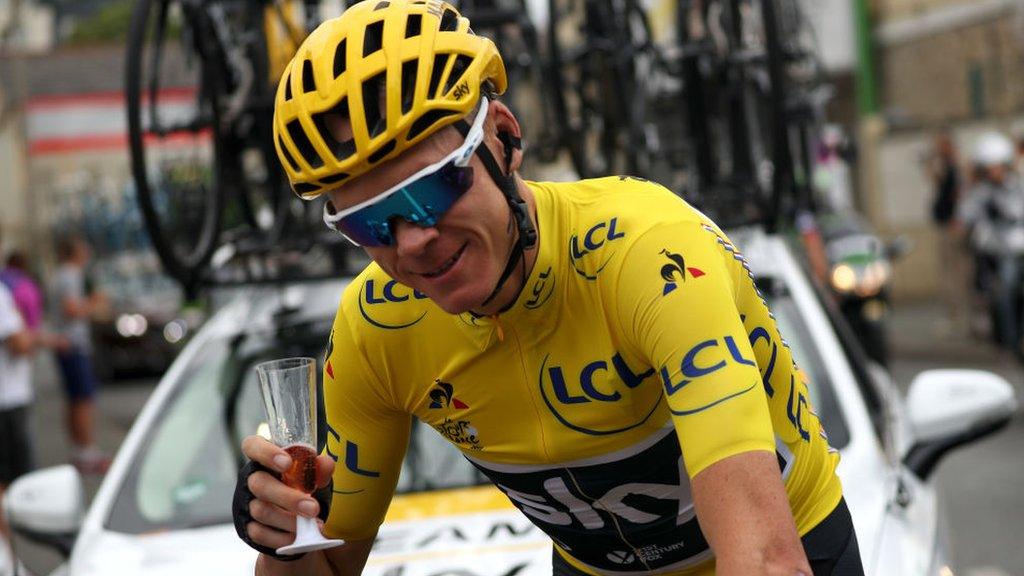Vuelta a Espana 2017: Why Chris Froome starts the race as favourite
- Published
- comments
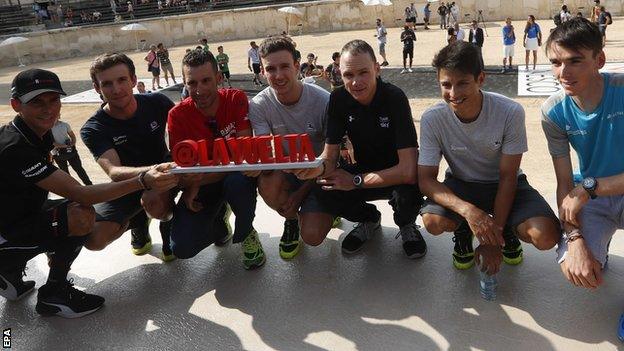
Britain has three contenders for the overall title in Simon Yates (second left), Adam Yates (centre) and Chris Froome (third right)
Chris Froome heads into the Vuelta a Espana looking to create more history by becoming the first British winner of the three-week race.
The four-time Tour de France winner made his breakthrough when finishing second in 2011's race to equal the then-best finish by a British rider in a Grand Tour.
Will he go one better this year and become the third man to complete the Tour-Vuelta double in the same year - and first since the Spanish race was switched from early to late in the season 22 years ago?
Froome goes into the race as favourite but with six of the top 10 from this year's Tour and the likes of four-time Grand Tour winner Vincenzo Nibali and Britain's Adam Yates in the mix, the Vuelta promises to be as tough as they come.
The race starts in Nimes in France on Saturday, 19 August and concludes in Madrid on Sunday, 10 September.
What is the Vuelta a Espana?
The youngest of the three annual Grand Tours, the Vuelta, like its cousins the Giro d'Italia and Tour de France, is a three-week race made up of 21 stages, raced over 23 days.
Prior to 1995 the race took place earlier in the season but often clashed with other major races so was switched to after May's Giro and July's Tour.
It was first raced in 1935, and aside from pauses for the Spanish Civil War and World War II, it has been contested continuously since 1955.
The 72nd edition of the race is starting outside of Spain for just the third time after Lisbon, Portugal in 1997 and Assen, Netherlands in 2009.
It is often an unpredictable race with riders racing who have suffered injuries or health problems earlier in the season, or those trying to rescue a failed season, while riders like Froome are trying to maintain their form from the Tour de France.
The route is notoriously mountainous, as evidenced by this year's race, which features nine summit finishes.
The route
"It's vicious," is Froome's take on it, while 2015 champion Fabio Aru says it will be the "usual horrendous race" and the "toughest stage race of the 2017 season".
The summit finishes are spread evenly across the three weeks with a mix of short, sharp climbs such as stage five's 3.5km ascent of Ermita Santa Lucia. It features gradients of 20%, while stage 15 finishes at an altitude of 2,510m in Sierra Nevada. The penultimate stage pits the riders against the infamous Alto de Angliru, where Sky lost the 2011 Vuelta when Froome waited for team leader Bradley Wiggins as Juan Jose Cobo launched a race-winning attack.
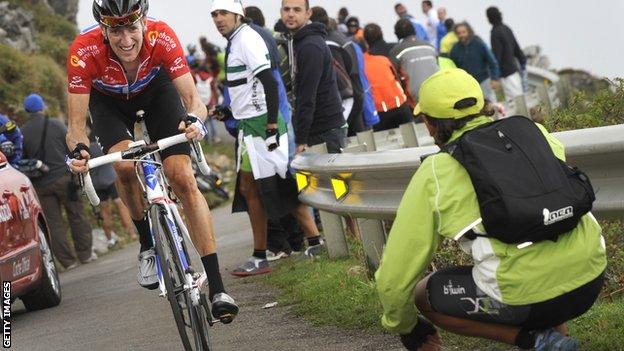
Bradley Wiggins' hopes of becoming the first British winner of the Vuelta in 2011 were ended on the Angliru
An opening team time trial in Nimes should not be long enough to create any significant time gaps between those chasing the overall victory but crucial seconds will be won and lost.
Race organisers will hope the 40km individual time trial on stage 16 will help balance out the climbs but it could just serve to strengthen Froome's grip on the title.
Sprinter-friendly stages are few, although those that make it to the finale are rewarded with a chance of glory in Madrid.
Why Froome is favourite
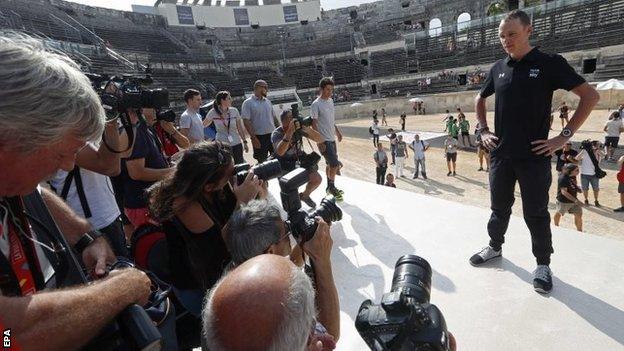
Chris Froome was in huge demand on the eve of the race in Nimes, southern France
In a nutshell, he can climb with the best in the race and is a better time-trial rider. He has finished runner-up on three occasions and goes into the race saying he has "unfinished business".
The 32-year-old also has arguably the strongest nine-man squad to help keep him out of trouble on flatter stages and set the pace on the tougher ascents. And, given his excellent form in the third and final week of July's Tour de France, Froome appears to have tailored his season to perfection, allowing him to also peak for the Vuelta.
On the eve of the race, he said: "The plan was to have a lighter first part of the season and I think that's worked. I certainly feel fresher. But whether that's reflected in the racing we'll have to wait and see."
Froome's rivals know they need to attack on ascents and descents in the mountains in the hope of picking up enough seconds to neutralise the time they will expect to lose in the 40km individual time trial.
And that stage 16 is one that Froome has earmarked. "The time trial is one day I'm looking forward to, a lot of time can be won or lost there," he said. "And of course stage 20 to the Angliru is a massive stage."
The rivals
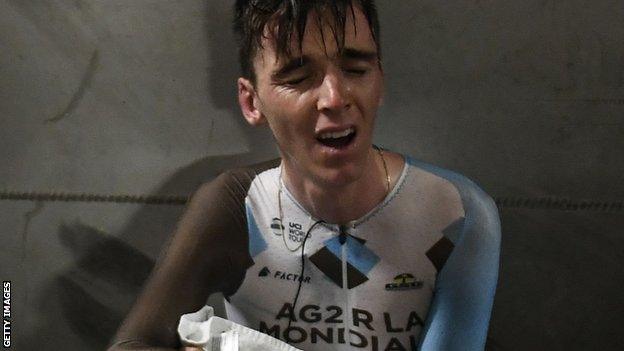
Romain Bardet almost blew a podium finish with a poor time trial at the Tour de France, holding on to third by just one second
Romain Bardet - the AG2R La Mondiale rider was the big hope for a first French Tour winner since 1985 in July, but he knows he needs to up his time trialling skills if he is to finally win a Grand Tour.
He lost almost two minutes to Froome over a 22km course in Marseille in July. Bardet, who is riding in his first Vuelta, said: "My ambitions will be different than in the Tour de France but surrounded by a strong team, I hope to make an impact on stages that suit me."
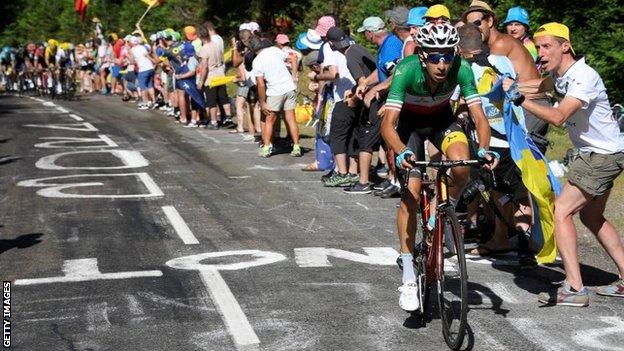
Italian champion Fabio Aru won the Tour's stage five, riding away from the field to win on La Planche des Belles Filles
Fabio Aru - the Italian won this race in 2015 and will love the steep climbs. However, he too lost significant time to Froome in the Tour's time trial and is wary of the Vuelta's team test on day one. He said: "I think I've recovered well after the Tour and have a good team with me.
We've got to limit the damage in the opening team time trail and be ready for the wind on Sunday. The nine uphill finishes means we'll be flat out all the time. It'll be good to watch, with time gaps each time."
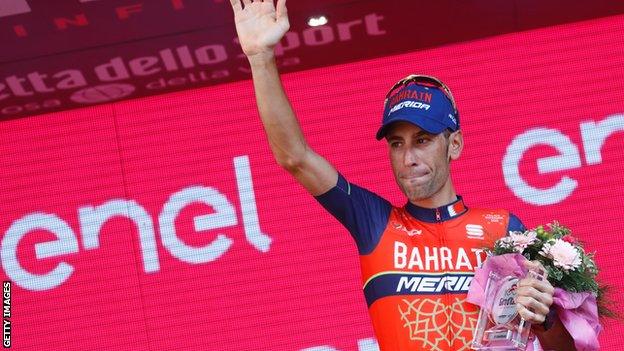
Vincenzo Nibali was unable to live up to his favourite tag, finishing third at the Giro d'Italia in May
Vincenzo Nibali - the Italian is one of six riders to have won all three Grand Tours and will be relatively fresh having missed the Tour after finishing third in the Giro.
Froome has picked out the Bahrain-Merida rider as his main threat. However, his team is not as strong as Sky's and he too will need to attack in the mountains because he is an inferior time trialler. He said: "I'm feeling pretty good. We'll find out how good along the road, day by day. I did a good block of training in the Dolomites that gave me the answers [about my form] that I was looking for."

Alberto Contador was stripped of the 2010 Tour and 2011 Giro titles after a positive doping test
Alberto Contador - the 34-year-old winner of eight Grand Tours is calling time on his career after the Vuelta but insists it won't be a lap of honour round his home country.
The three-time Vuelta winner said: "I have always given my maximum as a rider and I will do that now. This Vuelta is special, and I want to enjoy it. I feel lucky that I can be here, it's a really good place to say goodbye. So I want to see how the legs are feeling, see what kind of form my rivals have, but I have come with the idea of fighting to win and to enjoy it, too."
Don't rule out the Yates twins
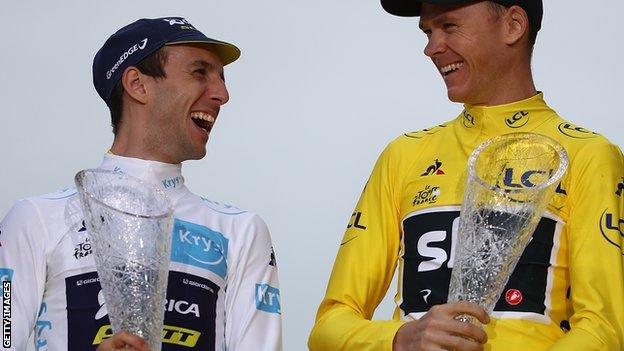
Simon Yates emulated Adam by winning this year's best young rider award at the Tour, finishing seventh overall
Aside from Froome, the Yates twins Adam and Simon provide the biggest hope of a podium finish for a British rider. The Orica-Scott pair are racing together in a Grand Tour for the first time since since the 2015 Tour de France and are part of a three-pronged attack for the Australian-based team.
Adam finished ninth at the Giro d'Italia in May and has a best Grand Tour finish of fourth at last year's Tour de France, when he also became the first Briton to win the young rider classification. Simon won that category in this year's race, finishing seventh overall, his best in a three-week race.
Both are competing in a second Grand Tour in the same year for the first time but Adam is buoyant about their chances, particularly because they also have renowned climber Esteban Chaves in their squad.
"If we can get on the podium, that'd be great, whether it's me, or Simon or Esteban," he told Cycling News.
"Esteban is another card we can play, especially in the third week. How many teams have three guys that can potentially be top 10, or even, depending on how much everybody else is going, top five?"
Simon is hopeful his body will "react in a positive way" after "keeping things ticking over" since finishing the Tour in July.
"We'll know in the early tough stages how I'm going," he added. "It depends on how my legs are. But as a team, either way, we're going to do quite well."
Ian Stannard is the only other Briton in Team Sky's squad and he will be tasked with helping keep Froome safe and in contention on the flatter sections.
The two other Britons in the race both ride for Irish team Aqua Blue Sport. Adam Blythe, the 2016 national road race champion will be looking to win sprint stages, while Mark Christian, who was seventh in the Tour de Yorkshire, is taking on his first Grand Tour.
The double
No rider has won all three Grand Tours in the same year, although Belgian legend Eddy Merckx did win four on the trot, the last two in 1972 and the first two in 1973.
Only Frenchmen Bernard Hinault (1978) and Jacques Anquetil (1963) have won the Vuelta and Tour in the same year and they achieved that at a time when the Spanish race preceded the French one.
In 1995 the Vuelta was switched to post-Tour and since then only four riders have finished in the top three in both races in the same year. Froome came closest to completing the double last year when he won the Tour and finished runner-up in the Vuelta.
The Giro-Tour double has been achieved most often, with Merckx doing it three of the 12 times, while the Giro-Vuelta double has been done three times.
Merckx (1973) and Italy's Giovanni Battaglin (1981) remarkably won both when they were raced with just a few days separating each Tour. Spain's Alberto Contador (2008) is the only victorious rider since the Vuelta was moved to late summer.
The jerseys
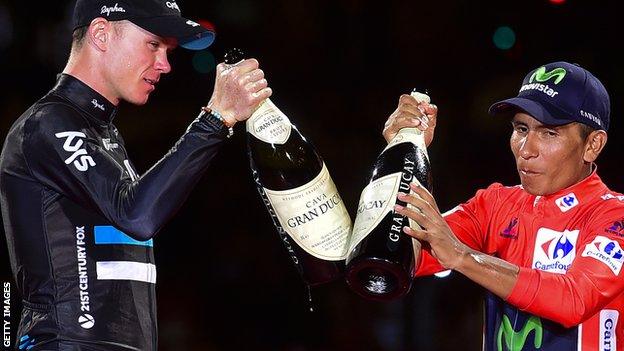
Nairo Quintana won last year's Vuelta from Froome but the Colombian will not defend his title after racing in the Giro and Tour this year
Red - the leader of the general classification. Worn by the rider with the lowest accumulated time
Green - the leader of the points classification. It rewards consistently high finishes and is worn by the rider who has picked up most points in sprint finishes and intermediate sprints
Blue and white polka dot - the leader of the King of the Mountains classification. It rewards consistently high finishes over categorised climbs and is worn by the rider who has picked up most points.
White - the combined jersey and one that is unique across the Grand Tours. Worn by the rider with the best combined results across the general classification, points and King of the Mountains competitions.
- Published8 September 2017
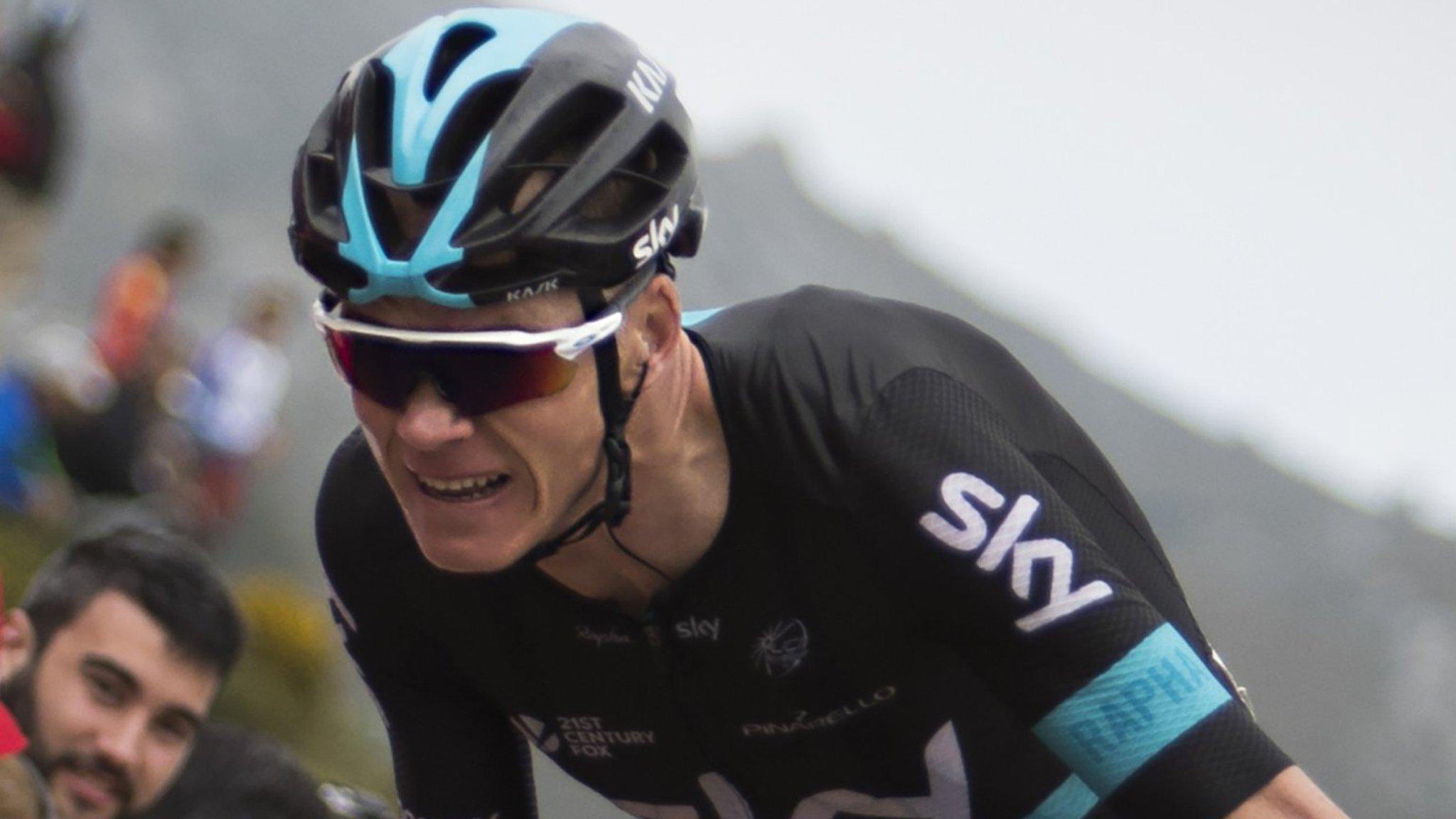
- Published17 August 2017
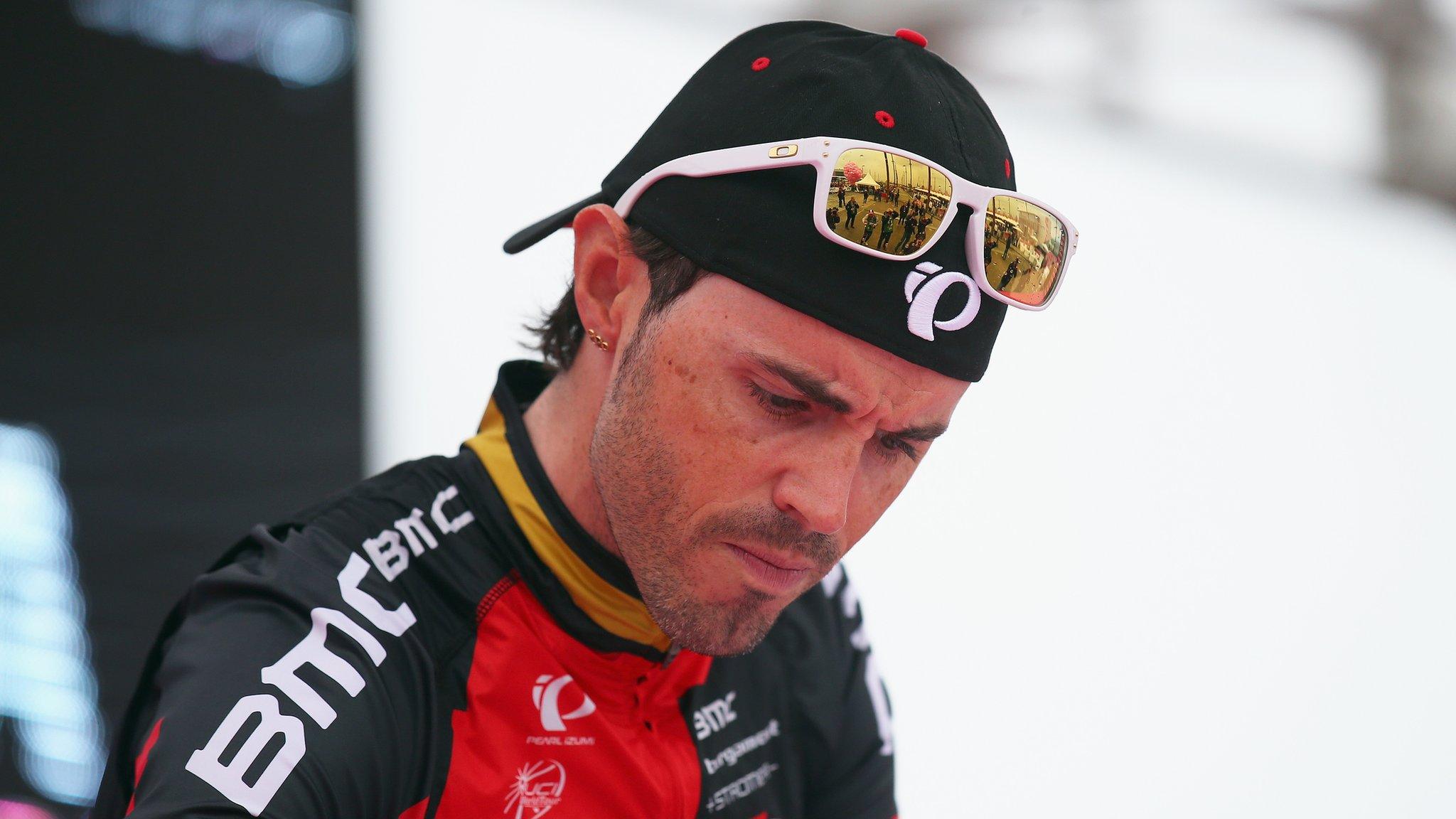
- Published14 August 2017
